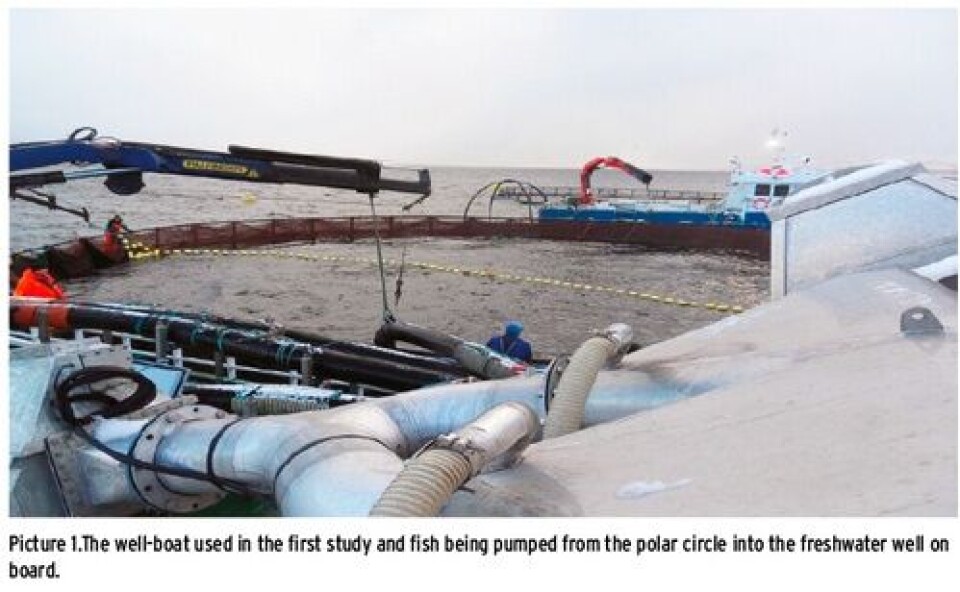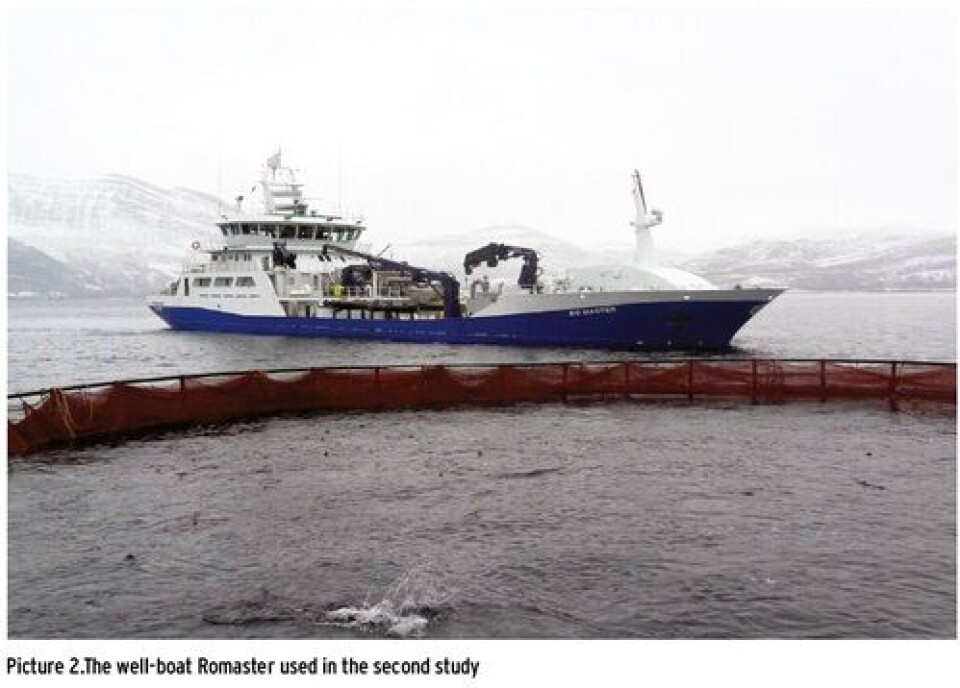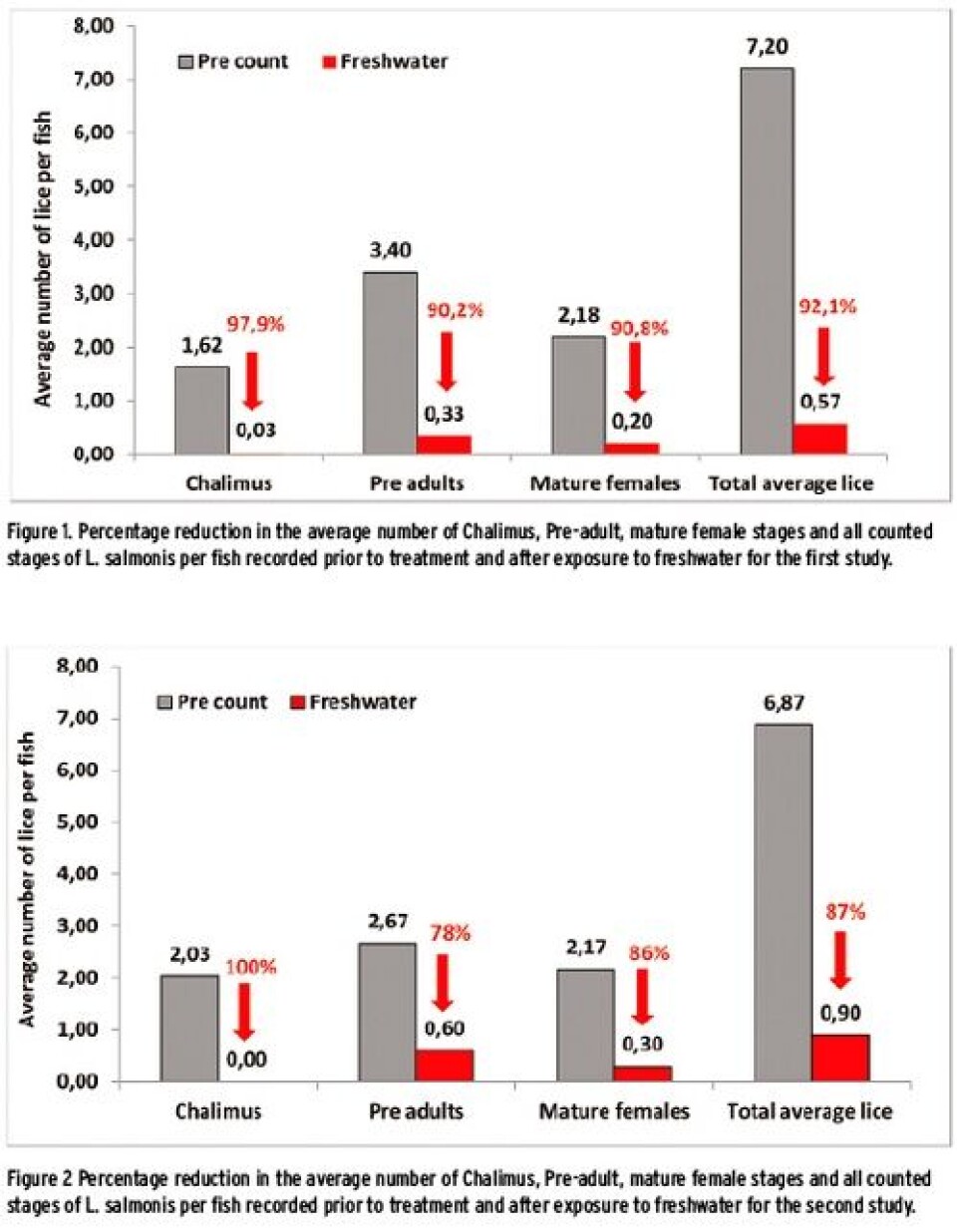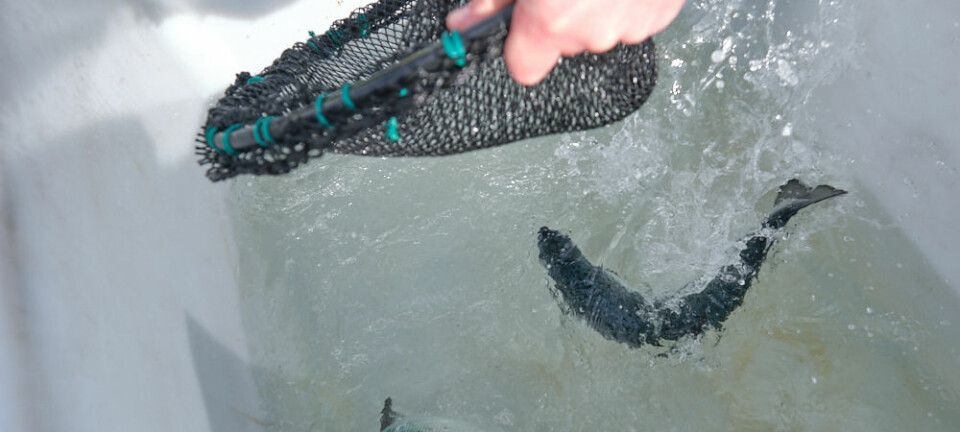Test of freshwater delousing of salmon in well-boats Part II
PATRICK REYNOLDS; GERHARD ELIASSEN; RONALD JØRGENSEN, GILDESKÅL FORSKNINGSSTASJON pat.reynolds@gifas.no
Previous studies undertaken at Gildeskål Research Station AS (GIFAS) investigated a practical solution to control sea lice in an environmentally friendly using freshwater as part of an integrated approach showed that exposing infected salmon to freshwater resulted in significant reductions of attached sea lice. A study undertaken in May 2013 was the first to transfer Atlantic salmon directly into a well containing freshwater using brønnbåten Havtrans (Havtrans AS). The study was attempted to assess the potential of using freshwater as an effective delousing agent under commercial conditions.

This study exposed approximately 23 tonnes of salmon for between three and four hours to freshwater and as a result; the average number of chalimus, pre adults and mature females per fish decreased by 100%, 97% and 92% respectively compared to the pre-treatment infection levels. The overall reduction of all stages of infective lice was calculated to be 96%. The study clearly showed that freshwater has the potential to be used as an effective delousing method on farmed Atlantic salmon under more realistic commercial scale conditions. However, further studies were required to further upscale the methods used in the present study so larger populations of salmon can be exposed to freshwater. The aim of this study was to assess this potential under more realistic commercial conditions by using a well-boat filled with freshwater and exposing a larger biomass of Atlantic salmon to the treatment for a defined period of time.
Methods Two separate studies were conducted at GIFAS large-scale facilities at Røssøya in October 2013 using Brønnbåten Brudanes (Havtrans AS) to perform the first study and Brønnbåten Romaster the second study. A lice count was undertaken to assess the lice burden prior to the test and after exposure. For the first study, the well-boat had one well filled with freshwater (0.16 ppt). 3004 Atlantic salmon with a mean weight of 5.06 kg were used in the study. All the fish were pumped into the freshwater well from a 90m polar circle onto the well-boat (Bilde 1). As the fish were pumped into the well, excess seawater was removed via a grid to ensure that the salinity of the freshwater was maintained during the study period. The time required to transfer the fish into the well was recorded and transfer from first to last fish in took one hour and ten minutes. Efficacy of treatment was assessed by undertaking a lice count two hours after transfer thus all fish were exposed to freshwater for between two hours and 3 hours 10 minutes.
For the second study, the well-boat Romaster had two wells: one filled with freshwater (0.28 ppt) and one filled with seawater (33.7 ppt. Approximately half the biomass in the cage (22000 Atlantic salmon with a mean weight of 5.06 kg) (110.4 T) were used in the study. The fish were pumped into the freshwater well from a 90m polar circle onto the well-boat (Picture 2). As the fish were pumped into the well, excess seawater was removed via a grid to ensure that the salinity of the freshwater was maintained during the study period. The remaining fish were pumped into the well containing seawater for delousing with hydrogen peroxide. The time required to transfer the fish into the well was recorded and transfer from first to last fish in took one hour and forty minutes. Efficacy of treatment was assessed by undertaking a lice count 35 minutes after transfer thus all fish were exposed to freshwater for between 35 minutes and 2 hours 15 minutes. For both studies, a lice count was performed on 30 fish which were netted directly from the well after each treatment.

Results For study 1, the percentage reduction in the average number of chalimus, pre adult, mature females and total lice can be seen in figure 1. There was a 97.9% reduction in chalimus stages for fish exposed to freshwater. For pre adult stages and mature females exposed to freshwater there was a 90.2% and 90.8% reduction respectively. The percentage reduction in the total average number of all stages of L salmonis was found to be 92.1% for fish after exposure to freshwater compared to pre-count values.
For study 2, the percentage reduction in the average number of chalimus stages after exposure to freshwater was 100% compared to pre-count values whilst reductions of 78% and 86% were recorded for pre-adult stages and mature female lice after freshwater exposure. The total percentage reduction in all attached stages for fish exposed to freshwater was calculated to be 87% (figure 2).
Summary/Conclusions The percentage reduction attained from both studies for all infective stages of sea lice found on Atlantic salmon exposed to freshwater (92% for study one and 87% for study two ) would be considered to be a successful treatment outcome and infection levels would be below treatment thresholds imposed under Norwegian legislation (0.5 sexually mature females per fish). The lower percentage levels of reduction recorded for study two may be attributed to a shorter exposure time to freshwater compared to fish exposed in study one (between 35 and 135 minutes for study two and 120 and 190 minutes for study one). The shorter exposure time was due to the study being terminated earlier than planned as the fish were showing signs of acute stress possibly due to potentially lowering pH levels. Results from previous studies undertaken at Gifas have shown that exposure times of between two and three hours have given excellent percentage reductions and this compares to the results recorded for study one. The most sensitive stages of L. salmonis appear to be the attached stages with percentage reductions of between 98 and 100% attained. There were differences between the temperature of the seawater (10.1 0C) and the freshwater contained within the well (5.5 0C) when study one was undertaken. This marked difference between seawater and freshwater may have contributed to the reduction in attached sea lice recorded. There is no current research that indicates that when the different stages of sea lice are exposed to abrupt changes in water temperature then survival is compromised. Further research is required to ascertain whether acute exposure to differing sudden changes in water temperature has an effect on sea lice survival.

Given the concerns of the development of resistance through treatment over-use and the fact that no new classes of chemotherapeutant treatments on the worldwide market are in a position to succeed the current range in use it is essential that alternative control measures are investigated. The previous and present studies have clearly shown that there is potential for freshwater to be used as part of an integrated approach to control sea lice infestations.
This present study clearly shows that freshwater has the potential to be used as an effective delousing method on farmed Atlantic salmon under realistic commercial scale conditions. These results show that survival of L. salmonis is severely compromised by short-term exposure to reduced salinity levels. This present study has clearly shown that infective stages of lice are susceptible to low salinity levels under 1 ‰ and that significantly high biomasses of salmon can be treated with well-boats filled with freshwater.
However, more work is required before the method can be used within the present industry. Further studies are required to further upscale the methods used in the present study so larger populations of salmon can be exposed to freshwater. In addition, a repeat study would assist in confirming these present results and also assist in identifying and modifying the method used to transfer fish to and from commercial-scale cages.























































